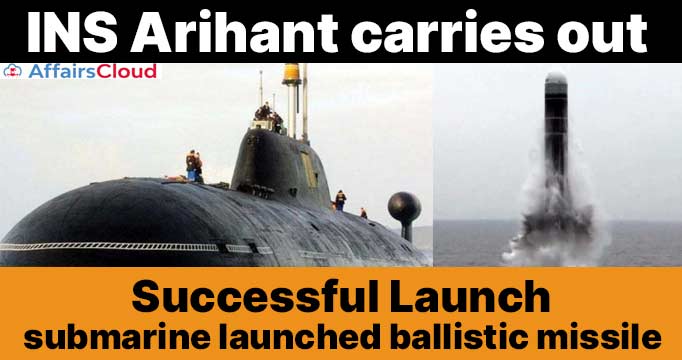
On October 14, 2022, the Indian Naval Ship (INS) Arihant, India’s first indigenous nuclear Ballistic Missile Submarine (SSBN-Submersible Ship Ballistic Missile Nuclear), successfully launched a nuclear capable Submarine Launched Ballistic Missile (SLBM), affirming India’s second strike nuclear capability.
- The missile that was launched is speculated to be the K-15 (also known as Sagarika), a member of the “K” family of SLBMs.
- In SSBN, SS denotes “submarine” or “submersible”, the B denotes “ballistic missile,” and the N denotes “nuclear powered.”
Significance
i.The missile tested to a predetermined range hit the target area in the Bay of Bengal with a very high degree of accuracy and validated all operational and technological aspects of the weapon system.
ii.The successful user training launch of the SLBM by INS Arihant is vital for the SSBN programme, which is a significant aspect of India’s nuclear deterrence capability.
iii.It is compatible with India’s policy of having “Credible Minimum Deterrence”(CMD) that supports its “No First Use”(NFU) policy to have a strong, resilient, and assured retaliatory capacity.
INS Arihant
i.The INS Arihant is India’s first indigenous nuclear-powered ballistic missile capable submarine and is part of the SSBN programme.
- It was launched in July 2009 on Kargil War Victory Day by then-Prime Minister Dr. Manmohan Singh’s wife, Gursharan Kaur, and commissioned in 2016.
ii.It was built as part of the classified Advanced Technology Vessel (ATV) project, which commenced in the 1990s.
- It has a displacement of 6,000 tonne and is powered by an 83 MW (megawatt) enriched uranium pressurized light-water reactor.
iii.INS Arihant and its class of submarines are designated as ‘SSBN,’ which is the hull classification mark for nuclear-powered ballistic missile-carrying submarines.
- While the vessel is operated by the Indian Navy, the operations of the SLBMs from the SSBN are administered by India’s Strategic Forces Command, which is part of India’s Nuclear Command Authority.
Advancements made after INS Arihant
i.India formally declared its “survivable nuclear triad”—the capability of launching nuclear strikes from land, air, and sea platforms—in November 2019, after INS Arihant completed its first deterrence patrol.
ii.After the United States (US), Russia, the United Kingdom (UK), France, and China, India is the sixth country in the world to deploy nuclear-powered submarines equipped with ballistic missiles.
iii.According to reports, the second submarine in the SSBN programme, the Arihant class ‘SSBN Arighat’, was launched in 2017 and is currently undergoing sea testing.
- SSBN is the most dependable platform for a second strike, as they are fuelled by nuclear reactors and can remain underwater indefinitely without being detected by the enemy.
- The other two platforms, land-based and air-launched, are significantly easier to detect.
Submarine Launched Ballistic Missiles (SLBMs)
i.The Submarine Launched Ballistic Missiles (SLBMs), also known as the ‘K’ family of missiles have been indigenously developed by Defence Research and Development Organisation (DRDO).
- The ‘K’ family is named after APJ Abdul Kalam, a key contributor in India’s missile and space programmes who also served as the 11th President of India.
- In 1998, India conducted nuclear tests under Phokran-II and in 2003 under the advisory of Late APJ Abdul Kalam , India declared its nuclear doctrine based on CMD and a NFU policy while reserving the right of retaliation if attacked with nuclear weapons first.
ii.The K-15 missile, also known as Sagarika, has been developed under the SLBM family and has a range of at least 750 kilometres (km).
iii.India has also developed and tested the same-family K-4 missiles with a range of 3,500 km.
- In January 2020, the Defence Research and Development Organisation (DRDO) had successfully test fired a 3,500 km range SLBM K-4 from a submerged pontoon off Visakhapatnam coast.
Recent Related News:
In September 2022, The Indian Navy launched two indigenously designed and built Diving Support Vessels (DSVs) – Nistar and Nipun in Visakhapatnam, Andhra Pradesh(AP). The first-of-its kind vessels were built by Hindustan Shipyard Limited.
About Indian Navy:
Chief of Naval Staff (CNS) – Admiral R Hari Kumar
Founded– 26 January 1950
Headquarters– New Delhi, Delhi




